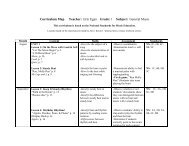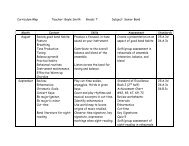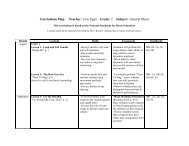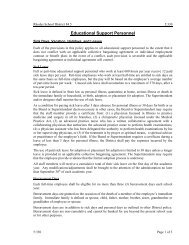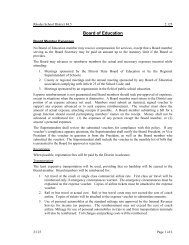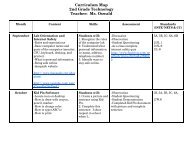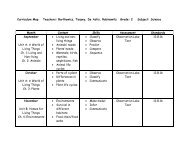Vocal Music Grade 5 - rhodes.k12.il.us
Vocal Music Grade 5 - rhodes.k12.il.us
Vocal Music Grade 5 - rhodes.k12.il.us
Create successful ePaper yourself
Turn your PDF publications into a flip-book with our unique Google optimized e-Paper software.
Curriculum Map Teacher: Erin Egan <strong>Grade</strong>: 5 Subject: General <strong>M<strong>us</strong>ic</strong><br />
This curriculum is based on the National Standards for <strong>M<strong>us</strong>ic</strong> Education.<br />
SB = Silver Burdett: Making <strong>M<strong>us</strong>ic</strong> (m<strong>us</strong>ic textbook series)<br />
Week Content Skills Assessment Standards<br />
1 Introduction to General <strong>M<strong>us</strong>ic</strong><br />
Classroom rules, required<br />
materials, name games<br />
-Identify the appropriate behaviors in the<br />
m<strong>us</strong>ic classroom<br />
N/A<br />
N/A<br />
UNIT: <strong>M<strong>us</strong>ic</strong>al Signs &<br />
Symbols<br />
Dynamics, articulation, tempo,<br />
notes, rests, measure, bar line,<br />
repeat, etc.<br />
DAILY LISTENING<br />
“<strong>M<strong>us</strong>ic</strong>al Moments” – Baroque<br />
Period<br />
Canon in D Major, Pachelbel<br />
Little Fugue in G Minor, Bach<br />
“Spring” from The Four Seasons,<br />
Vivaldi<br />
-Identify and notate the necessarily m<strong>us</strong>ical<br />
terminology for accurate m<strong>us</strong>ic reading<br />
(much of this should be review/culmination<br />
of previo<strong>us</strong> general m<strong>us</strong>ic knowledge)<br />
-Define the necessary m<strong>us</strong>ical terms and<br />
recognize them in context<br />
-Describe characteristics of m<strong>us</strong>ic from the<br />
Baroque period<br />
-Identify three iconic composers from this<br />
time<br />
-Identify m<strong>us</strong>ical characteristics of these<br />
pieces<br />
-Listen to and identify m<strong>us</strong>ical excerpts<br />
according to their characteristics<br />
Signs & Symbols Packet: -Students<br />
will take notes and draw symbol<br />
examples for each of the necessary<br />
terms<br />
-They will <strong>us</strong>e this to study for their<br />
quiz<br />
Signs & Symbols Review Stations:<br />
-Students can review their knowledge<br />
at three stations<br />
(a)Signs & Symbols Worksheet<br />
(b)Signs & Symbols Bingo (studentled)<br />
(c)Review notes/answer practice<br />
questions (teacher-led)<br />
“<strong>M<strong>us</strong>ic</strong>al Moments” Packet:<br />
-Given to students in order to<br />
take/organize notes on the<br />
information given<br />
Formative Assessments:<br />
-Several practice quizzes will be<br />
given and graded in class to assess<br />
students’ ability to identify each song<br />
and its composer<br />
NS: 4, 5<br />
NS: 6, 8, 9
1 cont.<br />
2 <strong>M<strong>us</strong>ic</strong>al Signs & Symbols cont.<br />
Time signatures, note/rest values<br />
& their placement within<br />
measures<br />
-Identify different time signatures and their<br />
meaning in the context of a piece of m<strong>us</strong>ic<br />
-Notate measures properly depending on the<br />
time signature given<br />
-Describe the necessity for time signatures<br />
in organized m<strong>us</strong>ic<br />
Time Signature Worksheet:<br />
-Students will identify time signatures<br />
and create measures accurately based<br />
on time signatures given<br />
-Worksheet will be graded for<br />
assessment<br />
Review Game:<br />
-Students will work together in<br />
groups to guess the correct time<br />
signature based on information given<br />
Signs & Symbols Partner Quiz:<br />
-Students will be assessed on their<br />
knowledge of the required terms;<br />
graded for assessment<br />
NS: 4, 5<br />
DAILY LISTENING cont.<br />
“<strong>M<strong>us</strong>ic</strong>al Moments” - Baroque<br />
Period<br />
Canon in D Major, Pachelbel<br />
Little Fugue in G Minor, Bach<br />
“Spring” from The Four Seasons,<br />
Vivaldi<br />
-Listen to and identify m<strong>us</strong>ical excerpts<br />
according to their characteristics<br />
-Connect pieces of m<strong>us</strong>ic to historical<br />
information<br />
“<strong>M<strong>us</strong>ic</strong>al Moments” Baroque<br />
Period Quiz:<br />
-Students will be assessed on their<br />
ability to identify songs and<br />
accurately answer questions about<br />
their characteristics/composers<br />
-<strong>Grade</strong>d assessment<br />
NS: 6, 8, 9<br />
3 SB: UNIT 1<br />
Lesson 5: Bananas Form<br />
Bunches<br />
“Day-O!” pp. 18-19<br />
Ain’t That Love (recording)<br />
Day-O! (excerpt), more info on p.<br />
21<br />
-Accompany a call-and-response song <strong>us</strong>ing<br />
rhythm instruments<br />
-Sing a call-and-response song<br />
-Disc<strong>us</strong>s the people, food, c<strong>us</strong>toms, and<br />
work life of the Caribbean<br />
-Invite students to choose a rhythm<br />
part at the top of p. 20 to accompany<br />
“Day-O!”<br />
-Have one player act as the leader<br />
(call) as others ply the response;<br />
observe students’ ability to accurately<br />
perform rhythm parts while singing<br />
NS: 1C,<br />
2C, 3B,<br />
4A, 5A,<br />
5C, 6B,<br />
8A, 8B
3 cont.<br />
the song<br />
Lesson 6: Over the Ocean<br />
“Bound for South A<strong>us</strong>tralia” p. 22<br />
-Sing a melody and read from notation <strong>us</strong>ing<br />
note names<br />
-Disc<strong>us</strong>s the history of sailing ships and<br />
their routes<br />
-Identify a song in AB form<br />
-Divide the class into two groups to<br />
demonstrate small-ensemble<br />
techniques<br />
-Have half of the class sing the calls<br />
with the other half singing the<br />
responses<br />
NS: 1C,<br />
2A, 3B,<br />
5C, 8B<br />
Lesson 7: Pentatonic Puzzle<br />
“Arirang” p. 25<br />
-Read a pentatonic melody from notation<br />
-Define the word “pentatonic”<br />
-Disc<strong>us</strong>s the meaning of the lyrics of a folk<br />
song from Korea<br />
-Students will sing “Arirang” while<br />
following staff notation<br />
-First <strong>us</strong>e hand signs and pitch<br />
syllables, then <strong>us</strong>e the song text<br />
-Observe students’ ability to<br />
accurately read and perform the song<br />
NS: 1C,<br />
3B, 5B, 8B<br />
DAILY LISTENING<br />
“<strong>M<strong>us</strong>ic</strong>al Moments” - Classical<br />
Period<br />
Symphony No. 40 in G Minor -<br />
Mozart<br />
Trumpet Concerto in Eb Major -<br />
Haydn<br />
Moonlight Sonata - Beethoven<br />
-Describe characteristics of m<strong>us</strong>ic from the<br />
Classical period<br />
-Identify three iconic composers from this<br />
time<br />
-Identify m<strong>us</strong>ical characteristics of these<br />
pieces<br />
-Listen to and identify m<strong>us</strong>ical excerpts<br />
according to their characteristics<br />
“<strong>M<strong>us</strong>ic</strong>al Moments” Packet:<br />
-Given to students in order to<br />
take/organize notes on the<br />
information given<br />
Formative Assessments:<br />
-Several practice quizzes will be<br />
given and graded in class to assess<br />
students’ ability to identify each song<br />
and its composer<br />
NS: 6, 8, 9<br />
4 Lesson 8: Follow the Melody<br />
“This Train”<br />
-Sing and read from notation a pentatonic<br />
melody<br />
-Read about and describe the Underground<br />
Railroad<br />
-Have students sing “This Train”<br />
-They may choose the first, second, or<br />
fourth phrase and sing it with hand<br />
signs and pitch syllables, then the<br />
text; observe their success at each<br />
stage<br />
NS: 1B,<br />
1C, 5B, 8B<br />
Lesson 10: Play An Ostinato!<br />
“Funwa alafia” p. 32<br />
“Kokoleoko” p. 33<br />
-Compose ostinato movement and<br />
instrument patterns<br />
-Describe characteristics of West African<br />
-Have students work in groups to<br />
create and perform a rhythmic<br />
ostinato accompaniment to the song<br />
NS: 1C,<br />
6B, 7A, 8B
4 cont.<br />
Yo Le Le (Funlani Groove)<br />
(excerpt)<br />
culture<br />
-Have students (a)list three goals<br />
relating to the accompaniment,<br />
(b)perform while the class sings the<br />
song, and (c)determine whether the<br />
goals were met<br />
Lesson 11: Let Nature Sing<br />
“I Love the Mountains” p. 34<br />
Sumer Is Icumen In (excerpt),<br />
listening map on p. 35 (<strong>us</strong>e<br />
interactive listening map)<br />
-Create harmony with the addition of<br />
ostinatos to the song<br />
-Identify ways that harmony can be created<br />
-Describe the texture of a song<br />
-Divide the class into small groups;<br />
ask each group to select instruments<br />
to add to a performance of “I Love...”<br />
-Have students perform several times,<br />
layering instruments with vocals<br />
-Assess their ability to answer the<br />
question: “What happened to the<br />
texture as instruments were added?”<br />
NS: 1A,<br />
2A, 4C, 6A<br />
DAILY LISTENING cont.<br />
“<strong>M<strong>us</strong>ic</strong>al Moments” - Classical<br />
Period<br />
Symphony No. 40 in G Minor -<br />
Mozart<br />
Trumpet Concerto in Eb Major -<br />
Haydn<br />
Moonlight Sonata – Beethoven<br />
-Listen to and identify m<strong>us</strong>ical excerpts<br />
according to their characteristics<br />
-Connect pieces of m<strong>us</strong>ic to historical<br />
information<br />
“<strong>M<strong>us</strong>ic</strong>al Moments” Classical<br />
Period Quiz:<br />
-Students will be assessed on their<br />
ability to identify songs and<br />
accurately answer questions about<br />
their characteristics/composers<br />
-<strong>Grade</strong>d assessment<br />
NS: 6, 8, 9<br />
5 Lesson 12: Broadway<br />
Harmony<br />
“Oklahoma” pp. 36-37<br />
Interview with Rebecca Luker<br />
Interview with Richard Rodgers<br />
-Discover how harmony is created by<br />
combining two different melodies<br />
-Disc<strong>us</strong>s the location and economy of<br />
Oklahoma<br />
-Describe the story of a famo<strong>us</strong> Broadway<br />
m<strong>us</strong>ical<br />
-Have students sing “Oklahoma” with<br />
the harmony part on p. 38<br />
-Assess their independence/ability to<br />
stay on pitch while singing either the<br />
melody or the harmony<br />
NS: 1D,<br />
2B, 6A,<br />
6B, 7B, 8B<br />
UNIT 2<br />
Introduction: Style and<br />
Movement<br />
“Choo Choo Ch’Boogie” pp. 44-<br />
45<br />
-Sing along to a bebop song<br />
-Maintain the steady beat while<br />
clapping/tapping on beats 2 and 4<br />
-Create movements to demonstrate an<br />
ability to stay with the tempo<br />
-Have students split into small<br />
groups; each group should develop a<br />
short dance demonstrate their ability<br />
to move accurately to this type of<br />
song<br />
NS: 3, 4,<br />
6, 8
5 cont.<br />
-Assess their ability to maintain a<br />
steady beat<br />
Lesson 1: Expressing<br />
Friendship<br />
“Stand by Me” pp. 46-47<br />
-Sing a song, <strong>us</strong>ing expressive qualities<br />
-Identify the symbols and meaning for<br />
crescendo and decrescendo<br />
-Describe how songs from the 1950s and<br />
1960s still have popular appeal today<br />
-Assess the students for their<br />
understanding of dynamics while<br />
performing “Stand by Me” in small<br />
groups<br />
-Observe their ability to remember<br />
and portray the crescendos and<br />
decrescendos<br />
-Observe students to assess their<br />
understanding of “lead” singers and<br />
“back-up” singers in a performance<br />
NS: 1C,<br />
1D, 2B,<br />
6B, 7B, 8B<br />
Lesson 4: Work to the Rhythm<br />
“Drill, Ye Terriers” pp. 54-55<br />
Symphony No. 9, Mvt. 1 (excerpt)<br />
-Play and sing sixteenth-note rhythmic<br />
patterns<br />
-Investigate and describe the historical<br />
context of a railroad song<br />
-Have students play and/or sing the<br />
rhythmic patterns, especially those on<br />
p. 55<br />
-Observe them for rhythmic accuracy<br />
-Have students perform the<br />
accompany dance routine to “Drill,<br />
Ye Terriers” and assess their ability to<br />
sing these patterns while moving<br />
NS: 1B,<br />
2B, 5A,<br />
5D, 6A, 8B<br />
DAILY LISTENING<br />
“<strong>M<strong>us</strong>ic</strong>al Moments” - Romantic<br />
Period<br />
“La donna e mobile” from<br />
Rigoletto, Verdi<br />
William Tell Overture, Rossini<br />
Vltava (The Moldau), Smetana<br />
Waltz No. 6 in Db Major (The<br />
Minute Waltz), Chopin<br />
-Describe characteristics of m<strong>us</strong>ic from the<br />
Romantic period<br />
-Identify four iconic composers from this<br />
time<br />
-Identify m<strong>us</strong>ical characteristics of these<br />
pieces<br />
-Listen to and identify m<strong>us</strong>ical excerpts<br />
according to their characteristics<br />
“<strong>M<strong>us</strong>ic</strong>al Moments” Packet:<br />
-Given to students in order to<br />
take/organize notes on the<br />
information given<br />
Formative Assessments:<br />
-Several practice quizzes will be<br />
given and graded in class to assess<br />
students’ ability to identify each song<br />
and its composer<br />
NS: 6, 8, 9<br />
6 Lesson 5: New Land, New<br />
Verse<br />
“Away to America” p. 57<br />
-Sing a song in verse/refrain form<br />
-Identify sections of a song as the verse and<br />
the refrain<br />
-Have students work in groups; ask<br />
each group to choose another song in<br />
verse/refrain form and decide on a<br />
NS: 1C,<br />
6B, 7A, 8B
6 cont.<br />
Theme and Variations Activity<br />
12 Variations on “Ah, vo<strong>us</strong> diraije,<br />
maman” K 265, Mozart<br />
-Disc<strong>us</strong>s immigration to the United States<br />
-Describe what it means for a song to be a<br />
theme and variations<br />
-Identify where new variations occur<br />
-Describe with m<strong>us</strong>ical terms the<br />
differences that create new variations<br />
way to perform the song that will<br />
highlight the two sections<br />
-Have students present their ideas to<br />
the class; evaluate their effectiveness<br />
in performance<br />
NS: 6, 7, 9<br />
Lesson 9: Perc<strong>us</strong>sion Near and<br />
Far<br />
“Ye jaliya da” p. 67<br />
Theme and Variations for<br />
Perc<strong>us</strong>sion (listening map on p.<br />
65)<br />
Montage of African Instruments<br />
Oya (Primitive Fire) (info on p.<br />
67)<br />
-Listen to a composition for perc<strong>us</strong>sion<br />
ensemble<br />
-Disc<strong>us</strong>s the role of m<strong>us</strong>ic in African culture<br />
-Identify different perc<strong>us</strong>sion instruments<br />
and their accompanying timbres<br />
Theme and Variations Chart:<br />
-Students will listen to, observe, and<br />
describe the changes that occur in<br />
several different m<strong>us</strong>ical categories,<br />
including dynamics, tempo, texture,<br />
melody, harmony, and rhythm<br />
NS: 1C,<br />
2A, 4C,<br />
6A, 6B, 8B<br />
Lesson 12: Harmony in Beauty<br />
and Song<br />
“America, the Beautiful” p. 76<br />
“Let Freedom Ring” p. 77<br />
“America, the Beautiful/Let<br />
Freedom Ring” (recording,<br />
partner songs<br />
-Sing in harmony by performing two partner<br />
songs together<br />
-Describe the origin of “America, the<br />
Beautiful”<br />
-Identify characteristics two songs m<strong>us</strong>t<br />
have to work as partner songs<br />
-Define and identify different textures in<br />
m<strong>us</strong>ic<br />
Observation/Journal Writing:<br />
-Play recording of Theme and<br />
Variations for Perc<strong>us</strong>sion and display<br />
listening map<br />
-Invite students to point to the<br />
variations as they occur<br />
-Observe their ability to aurally<br />
recognize these changes<br />
-Ask students to write a brief<br />
description of the perc<strong>us</strong>sion timbres<br />
<strong>us</strong>ed in this piece; assess their<br />
accuracy<br />
NS: 1B,<br />
1D, 6B,<br />
6C, 8B, 9B<br />
DAILY LISTENING cont.<br />
“<strong>M<strong>us</strong>ic</strong>al Moments” - Romantic<br />
Period<br />
“La donna e mobile” from<br />
-Listen to and identify m<strong>us</strong>ical excerpts<br />
according to their characteristics<br />
-Connect pieces of m<strong>us</strong>ic to historical<br />
information<br />
-Have students write definitions of<br />
thin/thick texture<br />
-Sing songs as partner songs; observe<br />
students’ ability to maintain<br />
NS: 6, 8, 9
6 cont. Rigoletto, Verdi<br />
William Tell Overture, Rossini<br />
Vltava (The Moldau), Smetana<br />
Waltz No. 6 in Db Major (The<br />
Minute Waltz), Chopin<br />
7 UNIT 3<br />
Lesson 1: Express Your Pride<br />
“The Voices of Pride” p. 87-88<br />
When Johnny Comes Marching<br />
Home (recording, listening map<br />
on p. 89)<br />
-Identify and describe dynamics and<br />
articulation<br />
-Describe how these m<strong>us</strong>ical characteristics<br />
help create a theme and variations<br />
-Describe patriotic symbols and ways of<br />
expressing patriotism<br />
independence while performing<br />
-Ask students for description of how<br />
the texture changes as parts are added<br />
(becomes thicker)<br />
<strong>M<strong>us</strong>ic</strong>al Moments” Romantic<br />
Period Quiz:<br />
-Students will be assessed on their<br />
ability to identify songs and<br />
accurately answer questions about<br />
their characteristics/composers<br />
-<strong>Grade</strong>d assessment<br />
-Ask students to write down standard<br />
symbols for articulation and<br />
dynamics; assess their knowledge<br />
-Evaluate their responses to questions<br />
such as:<br />
(a) How do dynamics help create<br />
interest in the song?<br />
(b) Which articulations occur in<br />
which variations?<br />
NS: 1A,<br />
1C, 5A,<br />
6A, 6C,<br />
8B, 9C<br />
Lesson 2: The Colors of Nature<br />
“De colores” pp. 90-91<br />
“Chiapenecas” pp. 92-93<br />
Janitzio (excerpt) (info on p. 91)<br />
-Perform movement patterns in 3/4 meter<br />
-Describe traditional Hispanic folk art and<br />
folktales<br />
-Have students move to show the<br />
three-beat patterns as they sing the<br />
song selections<br />
-Invite students to improvise a threebeat<br />
rhythmic ostinato to accompany<br />
the song<br />
-Observe that their movements<br />
accurately reflect meter in 3<br />
NS: 1C,<br />
2A, 4C,<br />
5A, 5C, 6C<br />
Lesson 5: Form in <strong>M<strong>us</strong>ic</strong><br />
“Joshua Fought the Battle of<br />
Jericho” p. 101<br />
Standin’ in the Need of Prayer<br />
-Identify the structure of ABA form with<br />
movement<br />
-Discover simliar structure in m<strong>us</strong>ic and art<br />
-Describe the characteristics and<br />
-Ask students to work in small groups<br />
to create movement and/or rhythmic<br />
ostinatos that represent the different<br />
sections<br />
NS: 1C,<br />
2D, 4C,<br />
6A, 6B,<br />
8A, 8B
7 cont.<br />
(info on p. 103) backgrounds of African American spirituals -Assess their ability to perform these<br />
accurately while singing the spiritual<br />
8 Lesson 8: Learn by Ear and<br />
Eye<br />
“Jo’ashila” pp. 108-109<br />
-Move to the beat of a Navajo song<br />
-Identify phrases of the melody that are the<br />
same or are different<br />
-Have students walk to the beat of<br />
“Jo’ashila” and sing the phrase that<br />
starts with Jo’ashila each time it<br />
occurs<br />
-Observe that students accurately<br />
perform the phrase and maintain the<br />
steady beat<br />
NS: 1C,<br />
2C, 6A,<br />
6C, 8B<br />
UNIT: Reading and Writing<br />
<strong>M<strong>us</strong>ic</strong>al Notation on The Treble<br />
Clef<br />
General Information on <strong>M<strong>us</strong>ic</strong><br />
Notation<br />
Lines - E, G, B, D, F<br />
Spaces - F, A, C, E<br />
Ledger lines (time pending)<br />
-Notate correctly the pitches on both the<br />
lines and spaces of the treble clef<br />
-Identify these pitches in context<br />
Treble Clef Practice Packet:<br />
-Students will work on a variety of<br />
practice worksheets to gain accuracy<br />
and speed while reading pitches of the<br />
treble clef<br />
-<strong>Grade</strong>d assessment<br />
Treble Clef Bingo:<br />
-Use a bingo game to assess students’<br />
ability to recognize pitches correctly<br />
Treble Clef Quiz:<br />
-Students will correctly label and<br />
notate pitches on the treble clef<br />
-They will describe the phrases <strong>us</strong>ed<br />
to help remind them of these pitches,<br />
and describe general information<br />
about m<strong>us</strong>ical notation<br />
-<strong>Grade</strong>d assessment<br />
NS: 4, 5
9 UNIT: Composing with Found<br />
Sounds<br />
“Newspapers” - video from the<br />
m<strong>us</strong>ical Stomp!<br />
Found Sounds PowerPoint<br />
Presentation<br />
-Compose a song of sounds that describes a<br />
story<br />
-Use movement and materials to create<br />
different timbres<br />
-Identify characteristics of a good<br />
composition and include these strategies<br />
while composing<br />
“Stomp” Reflection:<br />
-Students will answer reflection<br />
questions about the video clip, such<br />
as: “How can we create something<br />
like this?”<br />
“Found Sound” Worksheet:<br />
-Students will review the terms and<br />
aspects of a found sound composition<br />
with this worksheet<br />
NS: 2, 3,<br />
4, 6, 7, 8, 9<br />
10 UNIT: Composing with Found<br />
Sounds (cont.)<br />
“Newspapers” – Video clip from<br />
the m<strong>us</strong>ical Stomp!<br />
Found Sounds PowerPoint<br />
Presentation<br />
-Compose a song of sounds that describes a<br />
story<br />
-Use movement and materials to create<br />
different timbres<br />
-Identify characteristics of a good<br />
composition and include these strategies<br />
while composing<br />
Composition Work Time:<br />
-Assess student ability to work well in<br />
groups to create a composition<br />
-Observe their thoroughness and their<br />
attention to required aspects of the<br />
composition<br />
Final Performance:<br />
-Students will perform their<br />
compositions for the entire class<br />
-Assess their knowledge of<br />
composition requirements through<br />
their performance<br />
Peer Review:<br />
-Each student will complete a<br />
reflection on each performance,<br />
determining whether or not they meet<br />
the requirements of the project and<br />
their overall impressions of the<br />
composition<br />
NS: 2, 3,<br />
4, 6, 7, 8, 9



